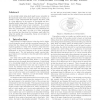Free Online Productivity Tools
i2Speak
i2Symbol
i2OCR
iTex2Img
iWeb2Print
iWeb2Shot
i2Type
iPdf2Split
iPdf2Merge
i2Bopomofo
i2Arabic
i2Style
i2Image
i2PDF
iLatex2Rtf
Sci2ools
ISQED
2003
IEEE
2003
IEEE
On Structural vs. Functional Testing for Delay Faults
A structurally testable delay fault might become untestable in the functional mode of the circuit due to logic or timing constraints or both. Experimental data suggests that there could be a large difference in the number of structurally and functionally testable delay faults. However, this difference is usually calculated based only on logic constraints. It is unclear how this difference would change if timing constraints were taken into consideration, especially when using statistical timing models. In this paper, our goal is to better understand how structural and functional test strategies might affect the delay test quality and consequently, change our perception of the delay test results.
| Added | 04 Jul 2010 |
| Updated | 04 Jul 2010 |
| Type | Conference |
| Year | 2003 |
| Where | ISQED |
| Authors | Angela Krstic, Jing-Jia Liou, Kwang-Ting Cheng, Li-C. Wang |
Comments (0)

